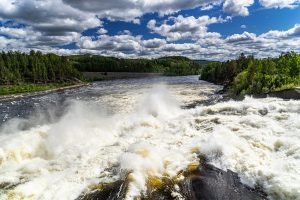Futureproofing Finance: business as usual is over
““Sustainability can only be achieved if all societal systems – including the financial system – are aligned to achieve this common objective. With a diverse cross-sectoral perspective, SIWI has a critical role to play to help financial actors understand water risks and opportunities, and how we collectively can achieve a water secure world.””
The CEO of Blackrock, worth $7 billion, couldn’t have been more clear in his annual letter to investors in 2020: ”climate risk is investment risk”. If the economy is going to survive and continue to thrive in the face of the climate crisis, it has to change – now. A sentiment echoed in a leaked report from JP Morgan, historically prolific in fossil fuel investment: “The climate crisis is a threat to the human race” – These statements are the latest in a long line which reveal how the finance sector is being shaken up by the ever increasing risk posed by the climate crisis. SIWI is hoping to build on this unprecedented momentum within sustainable finance to highlight the importance of water as a financial risk and how it can be mitigated.
This is of increasing importance as water-related risks continue to constitute many of the top risks in terms of global effects according to this years’ Global Risk Report from WEF report . Every year, the World Economic Forum (WEF) asks some 1,000 decision-makers from the public sector, business, academia and civil society across the globe to assess the risks facing the world over the decade to come. Whilst the climate crisis poses the most likely environmental risks, they are inextricably connected to economic interests which can be jeopardised by climate events. Climate resilience is make or break for businesses, according to the WEF’s environmental resilience team. Action is not enough, reaction must be planned for. “Even with strong climate action, we cannot avoid all of the consequences of climate change.” they continue – something the finance sector is all too aware of and has an active interest in helping to mitigate. This is where a unique opportunity presents itself to investors to influence and incentivize the companies they are investing in.
Investors can play two roles: they can ensure they are not investing in companies that are susceptible to climate risk in the form of water risk, but furthermore by ensuring they are not investing in companies that are actively worsening the water crisis thus jeopardizing the other companies in their portfolios they have the power to reduce the overall risk posed by water. This presents several difficulties for the investors: not only are there different types of risk to be aware of, there is a lack of shared statistics and measurements to substantiate risk analysis.
At the same time, the EU is taking unprecedented action in terms of aligning economic activities as well as the financial system with its Sustainable Development objectives. On December 11th, 2019, the EU Commission presented The European Green Deal – a roadmap for making the EU economy sustainable, and achieve net-zero carbon emissions by 2050. Earlier in March 2018, the EU Commission announced its Action Plan on Financing Sustainable Growth, which seeks to reorient capital flows towards sustainable investments, manage financial risks, and foster transparency. As part of the Action Plan, the EU has enforced new regulations on the creation of a unified classification system (‘taxonomy’) on what can be considered an environmentally sustainable economic activity, as well as updated regulations on disclosures relating to sustainable investments and sustainability. Combined, these initiatives illustrate a shift in thinking around the role of the financial community in pushing Sustainable development.
It is the first legislative document of this scope and specifies several activities that potential sustainable financial activity must avoid, one of which being: activity cannot breach the Do No Significant Harm principle to “Sustainable use and protection of water and marine resources”. Using our expertise across several aspects of water we provide a diverse cross-sectorial perspective on how water can pose a financial risk and how the ongoing climate crisis interacts with these risks.
Our task is to build on this momentum and ensure that water risk and opportunities are properly integrated as the financial community takes steps to actively engage with climate and wider sustainability issues. We seek to build upon the roadmap set forth by the EU, with a specific focus on the taxonomy, which stipulates that any economic activity must not do significant harm to “Sustainable use and protection of water and marine resources” to be taxonomy aligned.
Our goal is to develop practical guidelines for how investors can integrate water into portfolio management. In the US, the non-profit organization Ceres has laid the groundwork for this exercise, through the development of the Investor Water Toolkit. This toolkit allows investors to evaluate water risks across all asset classes and create strategies for understanding and mitigating water risks in their investment portfolios. SIWI will continue to build on this important work, and together with our Nordic partners, we will work to adapt this valuable tool to the Nordic context. More specifically, we will explore the possibilities for how to streamline investors water engagement with the new EU regulatory landscape on sustainable finance to ensure that water engagement is at the forefront of this transition.
Motivation for investors is two-fold: sustainable investments are long-term as they should be more resilient and retain their value in the context of a climate crisis. A second driving force is investment opportunity: products and services relevant to tackling the climate crisis will be in increasing demand and likely to be subject to subsidy. In helping investors realise these benefits and facilitate implementation of water risk analysis, SIWI continues its work towards a water wise world.










